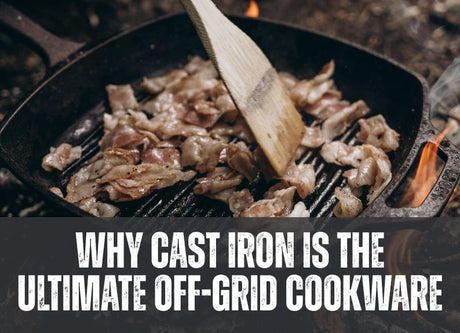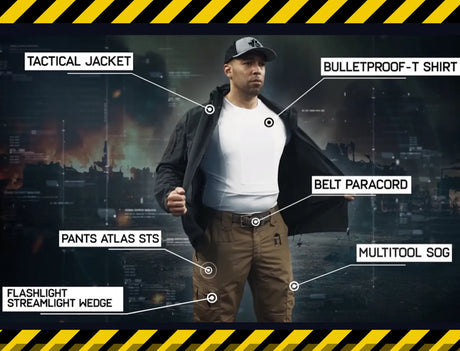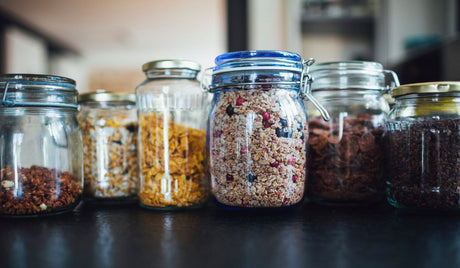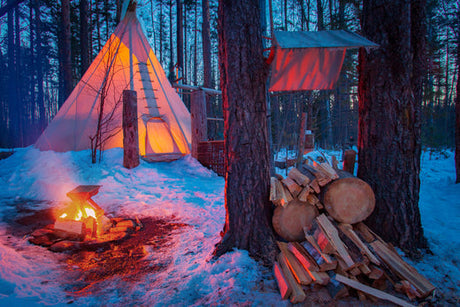Picture this: You're three days into a power outage during a brutal Canadian winter. The grid's down, your electric stove is useless, and your family is hungry. But you're not worried. Why? Because sitting on your wood stove is a trusty cast iron skillet, ready to turn anything in the pantry into a hot, satisfying meal that'll keep the whole family full.
This isn't just a fantasy scenario—it's the reality many of us face when we choose to live off-grid or prepare for emergencies. For me personally, after almost fifteen years of camping in Alberta, cooking over wood fires and weathering more power outages than I can count, I can tell you one thing with absolute certainty: cast iron cookware isn't just nice to have in your off-grid kitchen or campsite—it's absolutely essential.
Why Cast Iron Dominates Off-Grid Cooking
When you're living without the conveniences of modern utilities, every piece of equipment needs to earn its place. Cast iron doesn't just earn its spot—it becomes the cornerstone of your entire cooking operation.
Built to Last Generations (Literally)
Cast iron cookware represents the ultimate buy-once philosophy that every prepper should embrace. My grandmother's LODGE skillet, which I inherited and still use daily, is over 70 years old and performs better than most modern cookware. In a world where planned obsolescence rules, cast iron stands as a testament to old-world craftsmanship.
Unlike modern non-stick pans that lose their coating or thin aluminum that warps under high heat, properly maintained cast iron actually improves with age. Each use builds up the seasoning layer, making it more non-stick and more flavorful. When you're off-grid, you don't have the luxury of running to the store for replacement cookware—you need gear that'll outlast you.
Heat Retention That Changes Everything
Here's where cast iron really shines in off-grid scenarios: its incredible heat retention properties. When you're cooking over a campfire or on a wood stove, fuel efficiency matters. Cast iron absorbs heat slowly but holds it for an extraordinarily long time, meaning you can remove your pan from direct heat and continue cooking with residual warmth. (I leave mine safely in the corner of our tent for around 5 minutes to make it nice and toasty inside)
I've cooked entire meals using nothing but the heat stored in a well-heated cast iron Dutch oven, pulled away from the fire and allowed to finish cooking with retained heat. This isn't just convenient—it's a game-changer to keep food warm for hours.
Ultimate Versatility for Limited Resources
\When space and resources are at a premium, every piece of equipment needs to serve multiple purposes. Cast iron excels here like no other cookware. A single cast iron skillet can:
- Fry your morning eggs
- Bake cornbread (using the upside-down method over coals)
- Sear meat to perfection
- Serve as a makeshift griddle for flatbreads
- Double as a pizza stone
- Work as a serving dish that keeps food warm
A cast iron Dutch oven becomes even more versatile, functioning as a stockpot, bread oven, roasting pan, and even a makeshift smoker when you need it.
Mastering Cast Iron Seasoning in Off-Grid Conditions
- Proper seasoning is what transforms a piece of raw cast iron into a naturally non-stick cooking surface. While the process is the same whether you're on-grid or off, doing it in off-grid conditions requires some adjustments. Remember this step isn't necessary as most cast iron nowadays is pre seasoned but hitting it with that extra layer is so worth it in my opinion.
The Off-Grid Seasoning Process
What You'll Need:
- High smoke-point oil (flaxseed, grapeseed, or even lard)
- Clean rags or paper towels
- A reliable heat source (wood stove, propane burner, or well-managed fire)
- Patience
Step-by-Step Seasoning:
- Clean thoroughly - If it's new cookware, scrub off any factory coating with hot water and dish soap. For used pieces, remove any rust with steel wool.
- Dry completely - This is crucial. Any moisture left on the iron will cause rust. I place mine on a warm wood stove for several minutes to ensure complete drying.
- Apply thin oil layer - Using a clean rag, apply a very thin layer of oil to every surface—inside, outside, handle, everything. The key word here is thin. Too much oil creates a sticky, gummy surface instead of the smooth finish you want.
- Heat gradually - Place the cookware in your wood stove oven or over consistent heat. You want to reach the oil's smoke point and maintain it for at least an hour. With a wood stove, this means maintaining steady, moderate heat—not the roaring fire you'd use for heating.
-
Cool slowly - Let the piece cool naturally. Don't rush this process by moving it to a cold area.
Pro Tips for Off-Grid Seasoning Success
- Temperature Control Without a Thermometer: You'll know you've hit the right temperature when the oil just begins to smoke. Maintain this level—if you see heavy smoking, you've gone too hot and risk burning the oil instead of polymerizing it.
- Using Wood Stove Ovens: If your wood stove has an oven compartment, this is perfect for seasoning. The enclosed space provides even heat distribution. Place your oiled cookware upside down with a pan underneath to catch any drips.
- Emergency Seasoning Over Open Fire: You can season cast iron over an open fire, but it requires constant attention. Build up a good bed of coals for consistent heat, and rotate the piece frequently to ensure even heating.
Off-Grid Cooking Techniques That Actually Work
Cooking with cast iron over wood fires or on wood stoves is an art form that every off-grid enthusiast should master. Here's what I've learned through countless meals prepared this way.
Mastering Heat Management
The biggest mistake newcomers make is treating cast iron like modern cookware. Cast iron needs time to heat up properly, but once it does, it maintains that heat beautifully.
- The Preheat Rule: Always preheat your cast iron gradually. Place it near your heat source for several minutes before adding oil or food. You'll know it's ready when a drop of water dances across the surface and evaporates quickly. If the water steams you aren’t hot enough and need a few more minutes.
-
Zone Cooking: Create different heat zones in your cast iron by positioning different areas closer to or farther from your heat source. This gives you the equivalent of multiple burner temperatures in a single pan.
Wood Stove Cooking Strategies
Wood stoves provide the most consistent heat source for cast iron cooking. Here's how to make the most of it:
- Direct Surface Cooking: For high-heat searing, place your cast iron directly on the stove top. This works beautifully for steaks, chops, or getting a good sear on vegetables.
- Oven Compartment Magic: If your wood stove has an oven, this becomes your secret weapon. The enclosed space provides even, radiant heat perfect for baking bread, roasting meat, or slow-cooking stews. I like to reverse sear my steaks like this, bake them perfectly to 135°F, pull the cast iron out of the oven and sear over fire.
- Heat Banking: As your fire dies down, move your cast iron to different areas of the stove top to find the perfect temperature for different cooking stages.
Open Fire Techniques
Cooking over an open fire requires more skill but offers unmatched flavor:
- Coal Bed Cooking: Always cook over coals, not flames. Build your fire, let it burn down to hot coals, then push them to create your cooking surface.
- Dutch Oven Stacking: For baking over an open fire, place coals underneath your Dutch oven and on the lid. Use a 3:1 ratio—three-quarters of your coals on top, one-quarter underneath.
- Tripod Setup: A simple camp tripod over your fire pit lets you adjust the height of your cast iron, giving you precise temperature control
Maintenance That Keeps Your Cast Iron Performing
Proper maintenance in off-grid conditions requires some adjustments from standard advice, but it's actually simpler than most people think.
Post Cook Care Routine
- Immediate Cleaning: Clean your cast iron while it's still warm. Scrape out food particles with a wooden spatula, then rinse with hot water. Contrary to popular belief, a small amount of mild soap won't hurt properly seasoned cast iron.
- Thorough Drying: This is non-negotiable in off-grid conditions where humidity can be high. After washing, place the clean cast iron back on your heat source for a few minutes to evaporate every trace of moisture.
-
Light Oil Coating: While the cast iron is still warm, apply a very thin layer of oil and wipe it down with a clean cloth. This maintains the seasoning and prevents rust.
Dealing with Rust in Humid Conditions
Dealing with Rust in Humid Conditions
Canadian humidity, especially in summer, can challenge cast iron maintenance. If you discover rust spots:
- Scrub immediately with steel wool to remove all rust
- Re-season the affected area following the seasoning process
- Store properly in a dry location with good air circulation
Storage Solutions for Off-Grid Living
Dry Storage: In humid climates, to be super safe, store cast iron with a moisture-absorbing material like rice or silica gel packets in a sealed container. If you don't have rice, the sealed container is just fine.
Seasoning Maintenance: During periods of high humidity or infrequent use, check your cast iron monthly and apply a light oil coating as needed.
My Favourite Way to Use My Cast Iron
The best way I use my cast iron has to be during my camping trips to make warm bread. During a week-long stay at a remote cabin with only a wood stove for heat and cooking, my LODGE Dutch oven produced fresh bread every other day. Since I prepared the dough at home all I had to do was pop it in the oven and wait. There's something deeply satisfying about the smell of freshly baked bread filling a cabin when you're miles from the nearest store.
Your Next Step: Start with a single, quality piece—I recommend a 12-inch LODGE Blacklock skillet as your introduction to cast iron cooking. The blacklock line is slightly more expensive than their original line but the advantages of triple seasoning and the decreased weight make the experience much more enjoyable. Master the basics of seasoning and heat management with this one piece before expanding your collection. Practice at home so you're prepared for the camp site.
Cast iron isn't just cookware—it's an investment in your preparedness, your self-sufficiency, and your family's ability to thrive regardless of external circumstances. In a world that seems increasingly uncertain, there's profound comfort in knowing you can create delicious, nutritious meals using nothing but fire, iron, and skill.
The question isn't whether you can afford to invest in quality cast iron cookware—it's whether you can afford not to. Your future self, cooking a hot meal by candlelight while others struggle with cold food, will thank you for making that investment today.
Author Bio:
As the voice behind Brama Lifestyles, Michael Chiaravalloti shares a passion for exceptional living, whether it’s a gourmet meal under the stars or elevating everyday cooking with premium tools. With years of experience exploring outdoor culinary techniques and curating high-performance home equipment, Michael brings a unique blend of practicality and luxury to every article. When not testing the latest in cast iron or cold-smoked ingredients, they’re inspiring Canadians to cook with confidence—indoors or off-grid.










